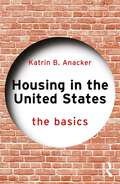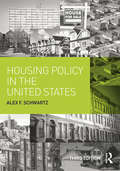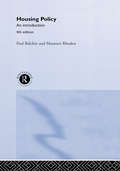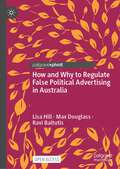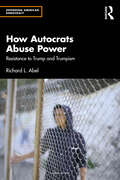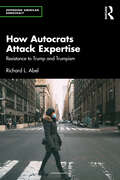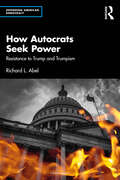- Table View
- List View
Housing in the United States: The Basics (The Basics)
by Katrin B. AnackerHousing matters to people, be they owner, renter, housing provider, homeless individual, housing professional, or policymaker. Housing in the United States: The Basics offers an accessible introduction to key concepts and issues in housing—and a concise overview of the programs that affect housing choices, affordability, and access in the United States today. Part I covers the fundamentals of housing: households, housing units, and neighborhoods; housing as basic need vs. human right; supply and demand; construction, rehabilitation, and renovation; and demographic, socioeconomic, and cultural trends. Part II focuses on housing policy and its evolution from the early 20th century, through the Great Recession to the present day; policies related to owner- and renter-occupied housing; tax policies and expenditures; place- and people-based programs; and shortages of affordable housing.Written in a clear and engaging style, this guide allows readers to quickly grasp the complex range of policies, programs, and factors that shape the housing landscape. Essential reading for students, community advocates, homebuyers/renters, and professionals with an interest in housing, it also serves as an ideal text for introductory courses in urban planning, urban studies, sociology, public administration, architecture, and real estate.This book provides a valuable and practical foundation for informed housing discussions at the kitchen table, in the classroom, at work, or on Capitol Hill.
Housing, Land and Property Rights: Residential Justice, Conflict Zones and Climate Change (Routledge Research in Human Rights Law)
by Scott LeckieThis book explores various contemporary aspects of the growing field of housing, land and property (HLP) rights. HLP rights have undergone a major transformation in recent decades, but much remains to be done to bring their promise to the billions of people who have yet to access them. This work presents several innovative ways by which the entire field of HLP rights can be strengthened in support of those to whom they are promised by human rights laws. It outlines the author’s suggestions for creating a new World Restitution Agency, expanding our understanding of the term ‘internationally wrongful act’ to HLP crimes, the links between mine action and HLP rights in post-conflict societies and the need to include HLP issues in peace agreements. The book concludes with several chapters that outline suggestions for better addressing climate displacement, including the need for national climate land banks, the role of the courts and how to redistribute global wealth towards rehousing the millions set to be displaced from their homes and lands due to the effects of climate change. The volume will be essential reading for academics, researchers and policymakers working in the areas of international human rights law, housing, land and property issues, humanitarian issues and climate change.
Housing, Land and Property Rights: Residential Justice, Conflict Zones and Climate Change (Routledge Research in Human Rights Law)
by Scott LeckieThis book explores various contemporary aspects of the growing field of housing, land and property (HLP) rights. HLP rights have undergone a major transformation in recent decades, but much remains to be done to bring their promise to the billions of people who have yet to access them. This work presents several innovative ways by which the entire field of HLP rights can be strengthened in support of those to whom they are promised by human rights laws. It outlines the author’s suggestions for creating a new World Restitution Agency, expanding our understanding of the term ‘internationally wrongful act’ to HLP crimes, the links between mine action and HLP rights in post-conflict societies and the need to include HLP issues in peace agreements. The book concludes with several chapters that outline suggestions for better addressing climate displacement, including the need for national climate land banks, the role of the courts and how to redistribute global wealth towards rehousing the millions set to be displaced from their homes and lands due to the effects of climate change. The volume will be essential reading for academics, researchers and policymakers working in the areas of international human rights law, housing, land and property issues, humanitarian issues and climate change.
Housing Law and Policy
by David CowanHousing Law and Policy goes beyond the usual sources of law in innovative ways. The author draws on socio-legal, economic and broader housing research in this critique of the development of both housing law and housing policy. In the three sections of the book he discusses the regulatory crisis affecting each housing tenure, access to housing, and finally individual housing rights in the context of a shift towards individual responsibility. The book takes an approach which is at once political, discursive and argumentative and will appeal to both students and professionals in the field.
Housing Law Handbook
by Diane AstinA comprehensive and accessible handbook that covers all the basic aspects of housing law, this book focuses on the practical: the common problems faced by advisers, court proceedings and the tactics of running a case, challenging decisions, and seeking remedies.
Housing Markets and Household Behavior in Japan (Advances in Japanese Business and Economics #19)
by Miki SekoThis book addresses essential questions about housing by building theoretical models based on various real world problems in Japan and testing these models using econometric methods. Almost all related empirical analyses use Japanese household longitudinal data. Accordingly, the author analyzes whole aspects of the data, based on an understanding of the actual situation, theory, and empirical analysis, to directly derive a vision of a future housing policy. Why are houses expensive and difficult to obtain in Japan? Why do people have to live in small houses? Why do people not relocate frequently? Why is the earthquake insurance subscription rate so low, particularly in an earthquake-prone country such as Japan, even after such a catastrophic event as the Great East Japan Earthquake of 2011? How do existing housing finance and tax policies or laws relate to these real world problems? To answer these questions, the book clarifies the unique criteria that characterize housing problems in Japan and presents a vision of future housing policy. The short answer is that existing housing finance policy that adopts criteria based on the floor space of houses creates incentives for people to live in even smaller houses. Furthermore, the Japan Rental Act, which affects people renting homes, reduces residential mobility. The incidence of underinsurance against earthquake risk is a result of earthquake insurance market imperfections such as crude and rough geographical risk ratings. The book elaborates on these factors in four parts and will be of interest to all readers who are concerned with the housing market and household behavior in Japan.
Housing Policy in the United States
by Alex F. SchwartzThe classic primer for its subject, Housing Policy in the United States, has been substantially revised in the wake of the 2007 near-collapse of the housing market and the nation’s recent signs of recovery. Like its previous editions, this standard volume offers a broad overview of the field, but expands to include new information on how the crisis has affected the nation’s housing challenges, and the extent to which the federal government has addressed them. Schwartz also includes the politics of austerity that has permeated almost all aspects of federal policymaking since the Congressional elections of 2010, new initiatives to rehabilitate public housing, and a new chapter on the foreclosure crisis. The latest available data on housing conditions, housing discrimination, housing finance, and programmatic expenditures is included, along with all new developments in federal housing policy. This book is the perfect foundational text for urban studies, urban planning, social policy, and housing policy courses.
Housing Policy in the United States
by Alex F. SchwartzThe classic primer for its subject, Housing Policy in the United States, has been substantially revised in the wake of the 2007 near-collapse of the housing market and the nation’s recent signs of recovery. Like its previous editions, this standard volume offers a broad overview of the field, but expands to include new information on how the crisis has affected the nation’s housing challenges, and the extent to which the federal government has addressed them. Schwartz also includes the politics of austerity that has permeated almost all aspects of federal policymaking since the Congressional elections of 2010, new initiatives to rehabilitate public housing, and a new chapter on the foreclosure crisis. The latest available data on housing conditions, housing discrimination, housing finance, and programmatic expenditures is included, along with all new developments in federal housing policy. This book is the perfect foundational text for urban studies, urban planning, social policy, and housing policy courses.
Housing Policy in the United States
by Alex F. SchwartzThe fourth edition of Housing Policy in the United States refreshes its classic, foundational coverage of the field with new data, analysis, and comparative focus. This landmark volume offers a broad overview that synthesizes a wide range of material to highlight the significant problems, concepts, programs and debates that all defi ne the aims, challenges, and milestones within and involving housing policy. Expanded discussion in this edition centers on state and local activity to produce and preserve affordable housing, the impact and the implications of reduced fi nancial incentives for homeowners. Other features of this new edition include: • Analysis of the impact of the Tax Cuts and Jobs Act of 2017 on housing- related tax expenditures; • Review of the state of fair housing programs in the wake of the Trump Administration’s rollback of several key programs and policies; • Cross- examination of U.S. housing policy and conditions in an international context. Featuring the latest available data on housing patterns and conditions, this is an excellent companion for graduate and advanced undergraduate courses in urban studies, urban planning, sociology and social policy, and housing policy.
Housing Policy in the United States
by Alex F. SchwartzThe fourth edition of Housing Policy in the United States refreshes its classic, foundational coverage of the field with new data, analysis, and comparative focus. This landmark volume offers a broad overview that synthesizes a wide range of material to highlight the significant problems, concepts, programs and debates that all defi ne the aims, challenges, and milestones within and involving housing policy. Expanded discussion in this edition centers on state and local activity to produce and preserve affordable housing, the impact and the implications of reduced fi nancial incentives for homeowners. Other features of this new edition include: • Analysis of the impact of the Tax Cuts and Jobs Act of 2017 on housing- related tax expenditures; • Review of the state of fair housing programs in the wake of the Trump Administration’s rollback of several key programs and policies; • Cross- examination of U.S. housing policy and conditions in an international context. Featuring the latest available data on housing patterns and conditions, this is an excellent companion for graduate and advanced undergraduate courses in urban studies, urban planning, sociology and social policy, and housing policy.
Housing Policy In The United States: An Introduction
by Paul Balchin Maureen RhodenHousing Policy in the United States is an essential guidebook to, and textbook for, housing policy, it is written for students, practitioners, government officials, real estate developers, and policy analysts. It discusses the most important issues in the field, introduces key concepts and institutions, and examines the most important programs. Written as an introductory text, it explains all concepts, trends, and programs without jargon, and includes empirical data concerning program evaluations, government documents, and studies carried out by the author and other scholars. The first chapters present the context surrounding US housing policy, including basic trends and problems, the housing finance system, and the role of the federal tax system in subsidizing homeowner and rental housing. The middle chapters focus on individual subsidy programs. The closing chapters discuss issues and programs that do not necessarily involve subsidies, including homeownership, mixed-income housing, and governmental efforts to improve access to housing by reducing discriminatory barriers in the housing and mortgage markets. The concluding chapter also offers reflections on future directions of US. housing policy.
Housing Policy In The United States: An Introduction
by Paul Balchin Maureen RhodenHousing Policy in the United States is an essential guidebook to, and textbook for, housing policy, it is written for students, practitioners, government officials, real estate developers, and policy analysts. It discusses the most important issues in the field, introduces key concepts and institutions, and examines the most important programs. Written as an introductory text, it explains all concepts, trends, and programs without jargon, and includes empirical data concerning program evaluations, government documents, and studies carried out by the author and other scholars. The first chapters present the context surrounding US housing policy, including basic trends and problems, the housing finance system, and the role of the federal tax system in subsidizing homeowner and rental housing. The middle chapters focus on individual subsidy programs. The closing chapters discuss issues and programs that do not necessarily involve subsidies, including homeownership, mixed-income housing, and governmental efforts to improve access to housing by reducing discriminatory barriers in the housing and mortgage markets. The concluding chapter also offers reflections on future directions of US. housing policy.
How AI, Metaverses, Crypto, and Cyber will Upend the 21st Century
by Jon M. GaronThis book explores the metamorphosis of fundamental social interactions and communal experiences, fuelled by technologies such as artificial intelligence, immersive online environments, augmented reality, blockchain, crypto and FinTech. It examines the competitors, regulators and governments who are locked in a struggle to control the economic and social future shaped by these technologies. Jon M. Garon tracks the evolution of the internet, video games, AI and emerging technologies as they converge into the transformative communications and commercial platform now known as the metaverse. He explains how each transformation in media influences and reshapes culture, and proposes ways in which metaverse platforms could operate in the public sphere. The book also discusses the efforts of governments across China, Europe and the United States to regulate the multinational companies responsible for these technologies, as well as comparing the conflicting views among states on what the metaverse should be. Providing practical guidance on the adoption of regulations in employment and educational settings, this book is essential reading for students, scholars and practitioners of antitrust and competition law, cyberspace law, finance and banking law, internet studies, and regulation and governance.
How The Aid Industry Works (PDF): An Introduction To International Development
by Arjan De HaanA concise introduction to the business of development.
How Algorithms Create and Prevent Fake News: Exploring the Impacts of Social Media, Deepfakes, GPT-3, and More
by Noah GiansiracusaFrom deepfakes to GPT-3, deep learning is now powering a new assault on our ability to tell what’s real and what’s not, bringing a whole new algorithmic side to fake news. On the other hand, remarkable methods are being developed to help automate fact-checking and the detection of fake news and doctored media. Success in the modern business world requires you to understand these algorithmic currents, and to recognize the strengths, limits, and impacts of deep learning---especially when it comes to discerning the truth and differentiating fact from fiction. This book tells the stories of this algorithmic battle for the truth and how it impacts individuals and society at large. In doing so, it weaves together the human stories and what’s at stake here, a simplified technical background on how these algorithms work, and an accessible survey of the research literature exploring these various topics. How Algorithms Create and Prevent Fake News is an accessible, broad account of the various ways that data-driven algorithms have been distorting reality and rendering the truth harder to grasp. From news aggregators to Google searches to YouTube recommendations to Facebook news feeds, the way we obtain information today is filtered through the lens of tech giant algorithms. The way data is collected, labelled, and stored has a big impact on the machine learning algorithms that are trained on it, and this is a main source of algorithmic bias – which gets amplified in harmful data feedback loops. Don’t be afraid: with this book you’ll see the remedies and technical solutions that are being applied to oppose these harmful trends. There is hope.What You Will LearnThe ways that data labeling and storage impact machine learning and how feedback loops can occurThe history and inner-workings of YouTube’s recommendation algorithmThe state-of-the-art capabilities of AI-powered text generation (GPT-3) and video synthesis/doctoring (deepfakes) and how these technologies have been used so farThe algorithmic tools available to help with automated fact-checking and truth-detectionWho This Book is ForPeople who don’t have a technical background (in data, computers, etc.) but who would like to learn how algorithms impact society; business leaders who want to know the powers and perils of relying on artificial intelligence. A secondary audience is people with a technical background who want to explore the larger social and societal impact of their work.
How and Why to Regulate False Political Advertising in Australia
by Lisa Hill Max Douglass Ravi BaltutisThis open access book represents the first comprehensive, Australia-focused treatment of the problem of false election information disseminated for the purpose of gaining an electoral advantage. It explores cautious legal regulation as the most effective and decisive approach to the issue. In doing so, the book demonstrates that, although experiments with such remedies have met with mixed success elsewhere, they are nevertheless viable, especially in Australia where they have strong public support and are able to withstand constitutional challenge.
How Antitrust Failed Workers
by Eric A. PosnerA trenchant account of an unacknowledged driver of inequality and wage stagnation in America: the failure of antitrust law to prevent the consolidation of employers, who use their market power to suppress wages. Since the 1970s, Americans have seen inequality skyrocket--and job opportunities stagnate. There are many theories of why this happened, including the decline of organized labor, changes in technology, and the introduction of tax policies that favored the rich. A missing piece of the puzzle is the consolidation of employers, which has resulted in limited competition in labor markets. This should have been addressed by antitrust law, but was not. In How Antitrust Law Failed Workers, Eric Posner documents the failure of antitrust law to address labor market concentration. Only through reforming antitrust law can we shield workers from employers' overwhelming market power. Antitrust law is well-known for its role in combatting mergers, price-fixing arrangements, and other anticompetitive actions in product markets. By opposing these practices, antitrust law enhances competition among firms and keeps prices low for goods and services. Less well-known, antitrust law also applies to anticompetitive conduct by employers in labor markets, which pushes wages below the competitive rate. Yet there have been few labor market cases or enforcement actions, and almost no scholarly commentary on the role of antitrust law in labor markets. This book fills the gap. It explains why antitrust law has failed to address labor market concentration, and how it can be reformed so that it does a better job. Essential reading for anyone interested in fighting economic inequality, How Antitrust Failed Workers also offers a sharp primer on the true nature of the American economyone that is increasingly uncompetitive and tilted against workers.
How Antitrust Failed Workers
by Eric A. PosnerA trenchant account of an unacknowledged driver of inequality and wage stagnation in America: the failure of antitrust law to prevent the consolidation of employers, who use their market power to suppress wages. Since the 1970s, Americans have seen inequality skyrocket--and job opportunities stagnate. There are many theories of why this happened, including the decline of organized labor, changes in technology, and the introduction of tax policies that favored the rich. A missing piece of the puzzle is the consolidation of employers, which has resulted in limited competition in labor markets. This should have been addressed by antitrust law, but was not. In How Antitrust Law Failed Workers, Eric Posner documents the failure of antitrust law to address labor market concentration. Only through reforming antitrust law can we shield workers from employers' overwhelming market power. Antitrust law is well-known for its role in combatting mergers, price-fixing arrangements, and other anticompetitive actions in product markets. By opposing these practices, antitrust law enhances competition among firms and keeps prices low for goods and services. Less well-known, antitrust law also applies to anticompetitive conduct by employers in labor markets, which pushes wages below the competitive rate. Yet there have been few labor market cases or enforcement actions, and almost no scholarly commentary on the role of antitrust law in labor markets. This book fills the gap. It explains why antitrust law has failed to address labor market concentration, and how it can be reformed so that it does a better job. Essential reading for anyone interested in fighting economic inequality, How Antitrust Failed Workers also offers a sharp primer on the true nature of the American economyone that is increasingly uncompetitive and tilted against workers.
How Asian Women Lead: Lessons for Global Corporations
by J. HoranHow Asian Women Lead provides a vastly different picture than Western-focused leadership literature, highlighting obstacles Asian women face reaching the top, and looking beneath the corporate surface to show cultural and family perspectives.
How Autocrats Abuse Power: Resistance to Trump and Trumpism (Defending American Democracy)
by Richard L. AbelChronicling and analyzing resistance to the threat that autocracy poses to American liberal democracy, this book provides the definitive account of both Trump’s efforts to erode democracy’s essential elements and opposition to those efforts. This book is about the threat of autocracy, which antedated Donald Trump and will persist after he leaves the stage. Autocrats blur or breach the separation of powers, use executive orders to bypass the legislature, pack the courts, replace career prosecutors with political appointees, abuse the pardon power, and claim immunity from the law. They seek to hobble opposition from civil society by curtailing speech and assembly, tolerating and even encouraging vigilante violence, and attacking the media. As this book demonstrates, Trump followed the autocrat’s playbook in many ways. He was a huckster of hate, aiming his vitriol at women and racial minorities and making attacks on immigrants the focus of his 2016 campaign, as well as his first years in office. Nevertheless, his rhetoric and policies encountered widespread opposition—from religious leaders, business executives, lawyers and bar associations, and civil servants. His executive orders (on which he relied) were almost all struck down by courts: including the first two “Muslim bans,” the detention of children and their separation from parents, the diversion of military funds to build the border wall, the insertion of a citizenship question in the census, and the limits on asylum. Just as Trump sought to weaponize the criminal justice system against his political opponents, so he manipulated it to defend his cronies, derailing some of their prosecutions. Trump also intervened in courts martial and criminal prosecutions of those convicted of war crimes in Afghanistan and Iraq and those accused of desertion and terrorism. Again, however, there was resistance, as some career prosecutors withdrew from cases or resigned when subjected to political pressure and federal courts convicted all of Trump’s allies—even though the president went on to use his unreviewable pardon power. This book, then, documents the abuses that are characteristic of autocracy and assesses the various forms of resistance to them. This definitive account and analysis of Trumpism in action, as well as the resistance to it, will appeal to scholars, students, and others with interests in politics, populism, and the rule of law and, more specifically, to those concerned with resisting the threat that autocracy poses to liberal democracy.
How Autocrats Abuse Power: Resistance to Trump and Trumpism (Defending American Democracy)
by Richard L. AbelChronicling and analyzing resistance to the threat that autocracy poses to American liberal democracy, this book provides the definitive account of both Trump’s efforts to erode democracy’s essential elements and opposition to those efforts. This book is about the threat of autocracy, which antedated Donald Trump and will persist after he leaves the stage. Autocrats blur or breach the separation of powers, use executive orders to bypass the legislature, pack the courts, replace career prosecutors with political appointees, abuse the pardon power, and claim immunity from the law. They seek to hobble opposition from civil society by curtailing speech and assembly, tolerating and even encouraging vigilante violence, and attacking the media. As this book demonstrates, Trump followed the autocrat’s playbook in many ways. He was a huckster of hate, aiming his vitriol at women and racial minorities and making attacks on immigrants the focus of his 2016 campaign, as well as his first years in office. Nevertheless, his rhetoric and policies encountered widespread opposition—from religious leaders, business executives, lawyers and bar associations, and civil servants. His executive orders (on which he relied) were almost all struck down by courts: including the first two “Muslim bans,” the detention of children and their separation from parents, the diversion of military funds to build the border wall, the insertion of a citizenship question in the census, and the limits on asylum. Just as Trump sought to weaponize the criminal justice system against his political opponents, so he manipulated it to defend his cronies, derailing some of their prosecutions. Trump also intervened in courts martial and criminal prosecutions of those convicted of war crimes in Afghanistan and Iraq and those accused of desertion and terrorism. Again, however, there was resistance, as some career prosecutors withdrew from cases or resigned when subjected to political pressure and federal courts convicted all of Trump’s allies—even though the president went on to use his unreviewable pardon power. This book, then, documents the abuses that are characteristic of autocracy and assesses the various forms of resistance to them. This definitive account and analysis of Trumpism in action, as well as the resistance to it, will appeal to scholars, students, and others with interests in politics, populism, and the rule of law and, more specifically, to those concerned with resisting the threat that autocracy poses to liberal democracy.
How Autocrats Attack Expertise: Resistance to Trump and Trumpism (Defending American Democracy)
by Richard L. AbelChronicling and analyzing resistance to the threat that autocracy poses to American liberal democracy, this book provides the definitive account of Trump’s assault on truth and his populist attacks on expertise, as well as scientific and legal opposition to them. This book is about the threat of autocracy, which antedated Donald Trump and will persist after he leaves the stage. Pandering to populists, autocrats attack professional expertise in an Orwellian world, where “ignorance is strength” and where, as Hannah Arendt wrote, people “believe everything and nothing.” Trump sought to inflame xenophobia by blaming China for the pandemic and closing U.S. borders, then declaring victory and, when that proved premature, wrongly blaming the number of tests for escalating cases. He sought to muzzle government scientists and denounced those who defied or evaded his directives as members of the “deep state,” preferring to rely on inexpert buddies. He elevated obscure scientists who promoted quack cures and opposed effective preventive measures while sidelining the few reputable experts, who nevertheless courageously resisted political interference. In addition to these, as this book documents, independent scientists, scientific journals and professional associations also outspoken, often more so. Even the pharmaceutical industry sought to preserve the integrity of a federal bureaucracy that assured the public the drugs they consumed were safe and efficacious. Following Trump’s numerous efforts to distort and undermine expertise, this book describes and evaluates the resilience of scientific and legal defenses of truth. This definitive account and analysis of the Trump’s populist rejection of truth and expertise will appeal to scholars, students and others with interests in politics, populism and the rule of law and, more specifically, to those concerned with resisting the threat that autocracy poses to liberal democracy.
How Autocrats Attack Expertise: Resistance to Trump and Trumpism (Defending American Democracy)
by Richard L. AbelChronicling and analyzing resistance to the threat that autocracy poses to American liberal democracy, this book provides the definitive account of Trump’s assault on truth and his populist attacks on expertise, as well as scientific and legal opposition to them. This book is about the threat of autocracy, which antedated Donald Trump and will persist after he leaves the stage. Pandering to populists, autocrats attack professional expertise in an Orwellian world, where “ignorance is strength” and where, as Hannah Arendt wrote, people “believe everything and nothing.” Trump sought to inflame xenophobia by blaming China for the pandemic and closing U.S. borders, then declaring victory and, when that proved premature, wrongly blaming the number of tests for escalating cases. He sought to muzzle government scientists and denounced those who defied or evaded his directives as members of the “deep state,” preferring to rely on inexpert buddies. He elevated obscure scientists who promoted quack cures and opposed effective preventive measures while sidelining the few reputable experts, who nevertheless courageously resisted political interference. In addition to these, as this book documents, independent scientists, scientific journals and professional associations also outspoken, often more so. Even the pharmaceutical industry sought to preserve the integrity of a federal bureaucracy that assured the public the drugs they consumed were safe and efficacious. Following Trump’s numerous efforts to distort and undermine expertise, this book describes and evaluates the resilience of scientific and legal defenses of truth. This definitive account and analysis of the Trump’s populist rejection of truth and expertise will appeal to scholars, students and others with interests in politics, populism and the rule of law and, more specifically, to those concerned with resisting the threat that autocracy poses to liberal democracy.
How Autocrats Seek Power: Resistance to Trump and Trumpism (Defending American Democracy)
by Richard L. AbelChronicling and analyzing resistance to the threat that autocracy poses to American liberal democracy, this book provides the definitive account of the rise of Trump’s populist support in 2016, and his failed efforts to nullify the result of the 2020 election.This book is about the threat of autocracy, which antedated Donald Trump and will persist after he leaves the stage. Autocracy negates both liberalism—which includes the protection of fundamental rights, the rule of law, separation of powers, and respect for specialist expertise—and democracy—which requires that the state be responsible to an electorate composed of all eligible voters—by concentrating unconstrained power in a single individual. Anticipating defeat in the 2016 election, Trump attacked suggestions that he had sought, or even benefited from, Russian assistance despite the evidence, and he made repeated claims of election fraud. In 2020, fearful that his mishandling of the pandemic had alienated voters, he intensified the allegations of fraud, demanding recounts, pressuring state legislatures and state election officials, advancing bizarre conspiracy theories, and finally, calling for a massive demonstration, urging protesters to march to the Capitol to pressure Congress, promising to accompany them. But as this book documents, Trump’s efforts to nullify the result of the 2020 election failed. As the courts rejected his numerous challenges, state election officials loyally performed their statutory duties, the Justice Department found no evidence of fraud, and politicians from all sides certified Biden’s victory, this book traces the many, and varied, forms of the defense of liberal democracy located within both the state and civil society, including law (judges, government lawyers, and private practitioners), the media, NGOs, science (and other forms of expertise), and civil servants (in federal, state, and local government). Evaluating their efficacy, the book maintains, is vital if—as history has repeatedly taught us—the price of liberal democracy, like that of liberty itself, is eternal vigilance.This definitive account and analysis of Trumpism and the resistance to it will appeal to scholars, students, and others with interests in politics, populism, and the rule of law and, more specifically, to those concerned with resisting the threat that autocracy poses to liberal democracy.
How Autocrats Seek Power: Resistance to Trump and Trumpism (Defending American Democracy)
by Richard L. AbelChronicling and analyzing resistance to the threat that autocracy poses to American liberal democracy, this book provides the definitive account of the rise of Trump’s populist support in 2016, and his failed efforts to nullify the result of the 2020 election.This book is about the threat of autocracy, which antedated Donald Trump and will persist after he leaves the stage. Autocracy negates both liberalism—which includes the protection of fundamental rights, the rule of law, separation of powers, and respect for specialist expertise—and democracy—which requires that the state be responsible to an electorate composed of all eligible voters—by concentrating unconstrained power in a single individual. Anticipating defeat in the 2016 election, Trump attacked suggestions that he had sought, or even benefited from, Russian assistance despite the evidence, and he made repeated claims of election fraud. In 2020, fearful that his mishandling of the pandemic had alienated voters, he intensified the allegations of fraud, demanding recounts, pressuring state legislatures and state election officials, advancing bizarre conspiracy theories, and finally, calling for a massive demonstration, urging protesters to march to the Capitol to pressure Congress, promising to accompany them. But as this book documents, Trump’s efforts to nullify the result of the 2020 election failed. As the courts rejected his numerous challenges, state election officials loyally performed their statutory duties, the Justice Department found no evidence of fraud, and politicians from all sides certified Biden’s victory, this book traces the many, and varied, forms of the defense of liberal democracy located within both the state and civil society, including law (judges, government lawyers, and private practitioners), the media, NGOs, science (and other forms of expertise), and civil servants (in federal, state, and local government). Evaluating their efficacy, the book maintains, is vital if—as history has repeatedly taught us—the price of liberal democracy, like that of liberty itself, is eternal vigilance.This definitive account and analysis of Trumpism and the resistance to it will appeal to scholars, students, and others with interests in politics, populism, and the rule of law and, more specifically, to those concerned with resisting the threat that autocracy poses to liberal democracy.
